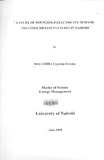| dc.description.abstract | The study set out to generate baseline data and information through the analysis of secondary data available from Kenya Power and Lighting Company Ltd (KPLC) for domestic consumers of electricity in a Nairobi residential estate and contrasting the same with the corresponding weather and economic data gathered from Kenya's Meteorological Department and the Ministry of Planning respectively. Through interviews, household ownership of electrical appliances and end-use patterns were also evaluated. The current model for forecasting domestic energy demand for power planning purposes was interrogated.
It was estat tshed that weather (temperature, wind speed and relative humidity) and Gross Domestic Product (GOP) per Capita had insignificant influence on domestic energy consumption and trends. The energy consumption in the short to medium terms is fairly constant save for the month of July, the coolest month in Kenya, when the demand increases by about 13%. The average annual electricity consumption per household in the urban middle income class estate was 2501 kWh. The average monthly energy consumption per household was 208 kWh. The average annual household power demand is 285W and the maximum demand is 3.6kW. The load factor is 7.9%, much lower than the interconnected system load factor of 69.9%.
There is a very high (over 80%) ownership and usage of refrigerators, TV, HiFi music systems, videos and cloth Irons. There is also a very high ownership of electric cookers (79%) and water heaters (geysers and instant showers) (68%). The other appliances with good penetration are computers (58%) and electric Kettles (42%). The other finding is that the penetration of energy efficient Compact Fluorescent Lamps (CFL) is 47% while that of incandescent lamps is 54%. Households that use incandescent lamps have a lighting load of 651 W while those using CFL have an installed lighting load of 192W, which is 3.3 times lower.
GOP, temperature, relative humidity and the interconnected system load factor are among the variables used in forecasting the household power and energy demand. These variables have been shown to have insignificant influence on short to medium term electricity demand. Therefore, the econometric model currently in use for forecasting short to medium term energy demand for the domestic consumer category needs to be reviewed. The end-use method is recommended for further investigation. | en_US |

